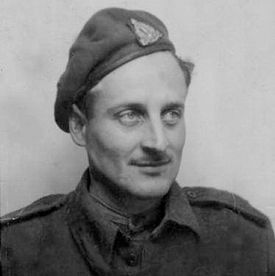Clark, William Domville
| William Domville Clark | |
|---|---|
| 11 July 1913 – 10 February 1945 | |
 | |
| Place of birth | Saint John, New Brunswick |
| Place of death | Netherlands |
| Place of burial | Groesbeek Canadian War Cemetery |
| Allegiance | Canada |
| Service/branch | Canadian Army |
| Years of service | 1940-1945 |
| Rank | Signalman |
Early Life
William Domville Clark was born on July 11, 1913 in Saint John, New Brunswick. He was the second eldest in a family of seven children, having four brothers and two sisters. His father, Richard Arden Clark was born in England in approximately 1890. His mother, Eva Brittain Clark (neé Richards, 1885 - 1939) was born in New Brunswick to a family of farmers. Richard immigrated to Canada in 1910, and in January 1911, they married in Saint John, New Brunswick. They would have eight children, one of whom, James Edward Clark (1924 - 1924) would die before he was five months old. His surviving siblings included Frederick Arden Clark (1911 – 1979) who was born in Central Greenwich, N.B. He served in the Royal Canadian Army in England and France. He also served in France and Holland as INT/OPS Staff.[2] Ernest Albert Clark (1914 - 1976) was born in Central Greenwich. He served with the South Saskatchewan Regiment. He participated in the Dieppe Raid but would survive the war and lived until 1976.[2] Richard W. Clark (1920 – 2009) was born in Oak Point, N.B. He served in the Royal Canadian Navy on the Fairmont and Corvette Owen Squad.[2] John A. Clark (1921- 2000) who was also born in Oak Point served in the Royal Canadian Army with the Carleton York in England, Italy, France, and Holland.[2] He later was a salesman who married in 1948. The eldest daughter was Grace Elizabeth Sneddon (neé Clark, 1917 - 2012). She would marry and later live in Toronto, ON. Frances Marie Hamilton (neé Clark, 1927) was the youngest child. She would marry and go on to become a switchboard operator in Toronto.
William only completed grade 9, leaving high school in 1929. He would, however, go on to do two years of night school in electrical at Saint John Vocational School from 1931-1933. From 1931-1935 he worked as a General Office Clerk for Jones Schofield and Hatheway, a grocery wholesaler and tea importer, in Saint John. From 1937 until his enlistment in 1940, William worked as a salesman for Electrolux Co. Ltd. Prior to his enlistment he enjoyed swimming, skating, fishing, as well as playing soccer, hockey, and rugby. He was five feet eight inches and 151 pounds. His family was of British-Canadian descent, spoke English, and attended the Church of England.
Service
William Clark served for an unknown time period in the active militia with No. 7 District Signals, R.C.C.S. prior to joining the Canadian Active Service Force on June 2, 1940. He enlisted in Saint John, New Brunswick, and was taken on strength of "H" Section, 3rd Canadian Divisional Signals, R.C.C.S. and was assigned service number G16011. At the time of enlistment, he stated that he desired to be an R.C.A.F. fighter pilot or technician. However, in his medical it was noted that he had worn glasses for eye strain, which may have been a factor in not being assigned to the R.C.A.F. From June 1940 until August 1940, he attended Basic Signal Training with 3 Div Sigs. Then on July 4, 1940, he was posted to Barriefield, ON. In August 1940, he was transferred to 2nd Canadian Divisional Signals, and in September he arrived at Gourock, Scotland, and was taken on strength at the No. 1 Signals General Holding Unit (C.S.H.U.). From September 1940 until November 1941 William attended the #1 C.S.H.U. Signal Training and Electrician Course at Cove Hantz, England. He successfully completed this course achieving Electrician Class II, Group B. Afterwards, he was posted to 1st Corps Signals as an Electrician. He became an Electrician "A" on July 17 1942. He completed weapons training throughout 1943. Throughout his service William suffered from multiple ailments, causing his hospitalization a handful of times. In March 1944, he was recommended to appear before a medical board to his ailments. Despite his health issues, on June 14, 1944, eight days after D-Day, William landed in France.
On February 10, 1945, while posted with the 19th Field Regiment Signals Section of First Canadian Army Signals, Sigmn William Clark was killed when he stepped on an enemy mine near the German border.[3] During this time Allied Forces were attempting to clear territory between the Maas and the Rhine.[4] He was interred at Groesbeek Canadian War Cemetery, plot 1, row B, grave 6.
Related Items
References and Footnotes
- ↑ Research by Kathryn Doull.
- ↑ 2.0 2.1 2.2 2.3 Royal Canadian Legion New Brunswick Vanagon, "Military Service Recognition Booklet". Accessed 16/06/2020.
- ↑ War Diary, 19th Field Regiment, RCA. February 1945.
- ↑ Veterans Affairs Canada, "Groesbeek Canadian War Cemtery". Accessed 7/06/2020.
